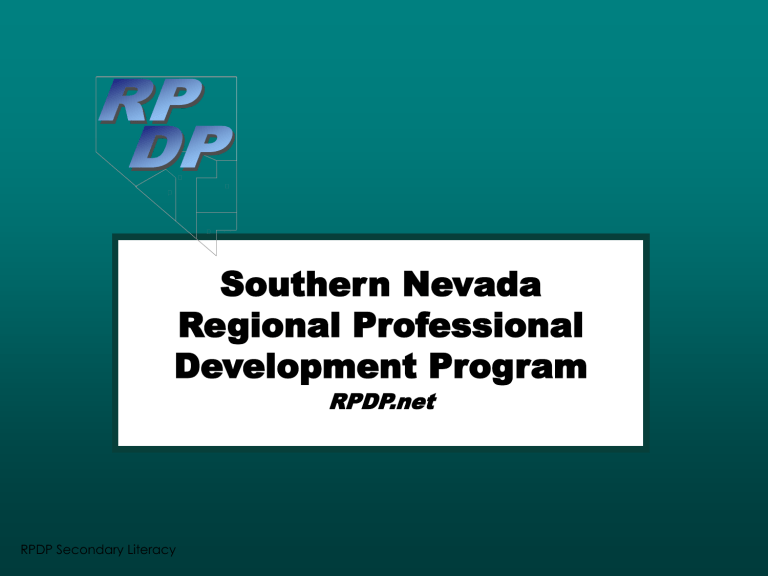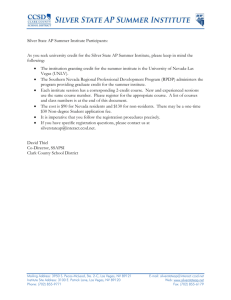Reading Fiction vs. Nonfiction

RPDP Secondary Literacy
Southern Nevada
Regional Professional
Development Program
RPDP.net
Reading Strategies
The Difference between Reading
Fiction and Nonfiction
Created and Developed by Jill Leone
Reading Specialist
Copyright © 2006
RPDP Secondary Literacy
• Students will recognize the difference between reading fiction and nonfiction text.
• Students will differentiate between strategies used to read these types of text.
• Students will apply these strategies to selected practice questions.
RPDP Secondary Literacy
Do you think you read everything the same way?
RPDP Secondary Literacy
Would you read a comic book the same way that -
RPDP Secondary Literacy
-you would read a road sign?
RPDP Secondary Literacy
RPDP Secondary Literacy
Or a newspaper?
The instructions to your new video game?
RPDP Secondary Literacy
What about a novel?
A menu?
RPDP Secondary Literacy
Or a textbook?
A contract?
A credit card statement?
Or a bank statement?
RPDP Secondary Literacy
Different types of reading passages require you to use different reading strategies.
RPDP Secondary Literacy
The strategies that you use generally depend on two things:
• Your purpose for reading
• Whether you’re reading fiction or nonfiction
RPDP Secondary Literacy
What is Fiction?
Fiction is anything that is invented or imagined by a writer.
Although it may be based on real people, events, or experiences, its characters and settings are invented.
RPDP Secondary Literacy
Through fiction, you come to understand your own life through the lives of others.
RPDP Secondary Literacy
The author’s job of writing is only half the process. You bring a story to life by using your imagination.
RPDP Secondary Literacy
Types of Fiction
Plays
Poetry
Short Stories and Novels
• Romance
• Mysteries
• Westerns
• Fantasy
• Science Fiction
• Historical Fiction
RPDP Secondary Literacy
How to Read Fiction
You read more quickly than nonfiction.
You form mental images by using your imagination to picture –
• how characters look
• where they live
• what they do.
RPDP Secondary Literacy
warnerbrothersstudios.com
Details in fiction are not as important as “the big picture.”
RPDP Secondary Literacy
How to Read Fiction
It’s usually easy to remember.
Many events are told in chronological order.
This helps you with your comprehension.
RPDP Secondary Literacy
The opposite of fiction is nonfiction.
Nonfiction tells about real people, places, events, thoughts, and times.
RPDP Secondary Literacy
You are informed of what’s happening in the world around you .
RPDP Secondary Literacy
Basic Types of Nonfiction
Narrative nonfiction tells a true story.
Expository nonfiction is factual and informative writing.
Persuasive nonfiction promotes an opinion or a position.
RPDP Secondary Literacy
Some nonfiction works tell a story, just as fiction works do.
Examples of narrative nonfiction:
• autobiographies
• biographies
• memoirs
• narrative essays
• newspaper and magazine articles
RPDP Secondary Literacy
More Examples of Nonfiction
Writing that expresses personal feelings and writers’ opinions
• Editorials and letters to the editor
• Reviews of books, movies, etc .
• Diaries and journals
• Personal essays
• Letters
RPDP Secondary Literacy
More Examples of Nonfiction
Information articles about how things work or came to be
Reading you do in a science, health, or history class
Technical articles that explain instructions or specialized procedure
RPDP Secondary Literacy
Today, almost everything you want to know -
RPDP Secondary Literacy
- is just a mouse click away.
Maybe more than any other reading, requires you to read critically and apply your prior knowledge.
RPDP Secondary Literacy
How to Read Nonfiction
Always try to figure out the writer’s purpose and intended audience.
Writers change strategies depending on their audience and purpose for writing.
When we understand why and for whom something was written, we understand it better.
RPDP Secondary Literacy
How to Read Nonfiction
Look at content & organization:
How ideas are organized
Which ideas are facts
Which ideas are opinions
Before you start to read, think about what you already know .
Read more slowly & carefully.
RPDP Secondary Literacy
How to Read Nonfiction
Nonfiction is mostly read for a particular purpose.
You read the newspaper to learn –
• what’s going on in the world
• look for a job
• check the sports or
• a movie review.
RPDP Secondary Literacy
How to Read Nonfiction
Nonfiction is about facts.
Details are important. You look at more than “the big picture.”
Questions usually have one best answer.
It’s often hard to form mental images.
RPDP Secondary Literacy
How to Read Nonfiction
Nonfiction is often difficult to remember.
The main idea is often – not always – in the first sentence of the paragraph.
The last sentence of the paragraph often – not always – sums up the main idea.
RPDP Secondary Literacy
How to Read Nonfiction
Often there are charts, tables, and graphs to help you understand what you’re reading.
This writing often uses titles and subtitles, which can help you figure out the main ideas.
The size of the headings, bold print, italicized and underlined words are there for a reason. Use them!
RPDP Secondary Literacy
Practice Question
Which of the following is not a characteristic of nonfiction?
A. Uses charts, tables, and graphs
B. Easier to remember
C. Details are important
D. Mostly read for a particular purpose
RPDP Secondary Literacy
Practice Question
Which of the following is not a characteristic of nonfiction?
A. Uses charts, tables, and graphs
B. Easier to remember
C. Details are important
D. Mostly read for a particular purpose
How did you do?
RPDP Secondary Literacy
Practice Question
Which of the following is an example of nonfiction writing?
A. A short story
B. A novel
C. An autobiography
RPDP Secondary Literacy
Practice Question
Which of the following is an example of nonfiction writing?
A. A short story
B. A novel
C. An autobiography
How did you do?
RPDP Secondary Literacy
A Quick Review
Today we discussed reading fiction –
Use your imagination to form mental images
“Big picture” more important than details
Read for pleasure
Read more quickly
Easier to remember
RPDP Secondary Literacy
A Quick Review
When reading nonfiction –
Figure out writer’s purpose and audience.
You have a purpose for reading
Look at content and organization.
Read more slowly and carefully.
Details important.
Difficult to form mental images.
Harder to remember.
RPDP Secondary Literacy
It doesn’t matter whether you read or nonfiction -
As long as you take the time to read!
RPDP Secondary Literacy
Copyright Notice
Permission is granted to copy (unmodified) all or part of this PowerPoint for educational, personal, noncommercial use off-line as long as the copyright message (Copyright © 2006 by Jill Leone) is maintained on the title page. This material may not be sold, duplicated on other websites, incorporated in commercial documents or products, or used for promotional purposes.
Copyright © 2006 by Jill M. Leone
RPDP Secondary Literacy









